How to Fix ‘Can’t Open asio3.sys’ Error on Windows 11 / 10
If you’re getting the ‘Can’t open AsIO3.sys – Failed with error code 5: Access is denied‘ error when attempting to install AURA Sync or another ASUS-related software on your PC; this article will help you fix it. We will dive into all the variations of this issue (on Windows 10 and Windows 11) and feature every confirmed fix that other users have used successfully.
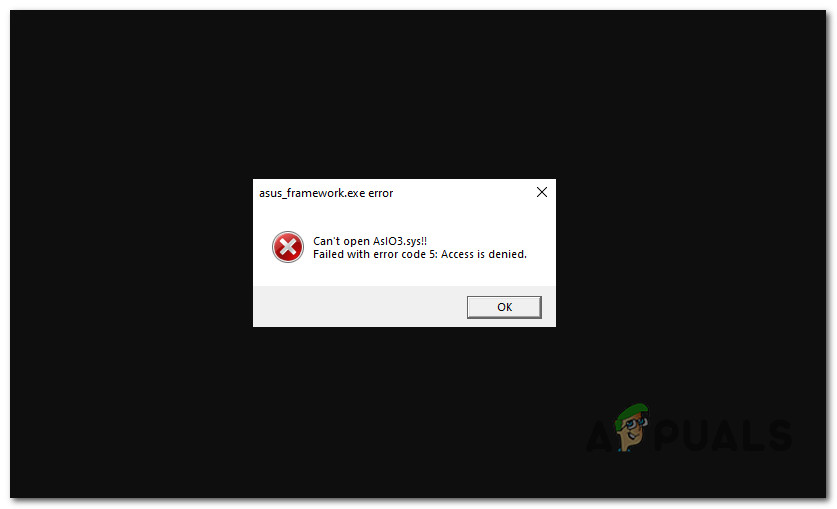
As you’ll see below, this error has a huge variety of potential culprits, as there are a lot of potential conflicts that might cause the “Can’t open asio3.sys” error.
1. Unblock the zip file
One of the most popular reasons this issue occurs is because the .zip file that you download (containing software that uses the AsIO3.sys) is blocked.
This issue is known to occur with older software builds – Until recently, every .zip file downloaded from the official ASUS support website was blocked.
To fix this issue and get around the ‘Can’t open AsIO3.sys‘, you’ll need to access the Properties screen of the .zip file and unblock it before carrying on the installation.
For specific instructions on how to do this, follow the steps below:
- Open File Explorer and navigate to the location of the .zip file.
- Right-click on it and choose Properties from the context menu that just appeared.
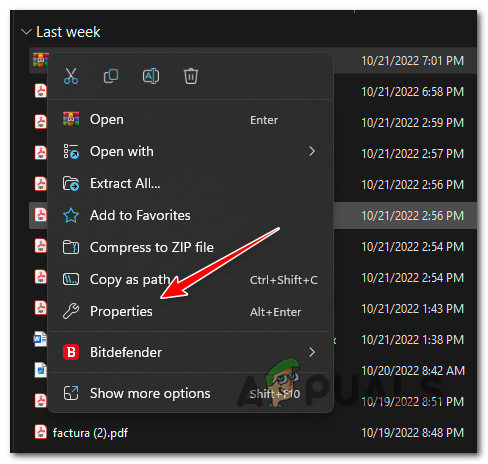
Access the Properties screen - Once you’re inside the Properties screen of the .zip file, access the General tab.
- Scroll down to the bottom of the page and see if you have a Security entry.
- Check the Unblock button before clicking on Apply if you spot a Security layer.
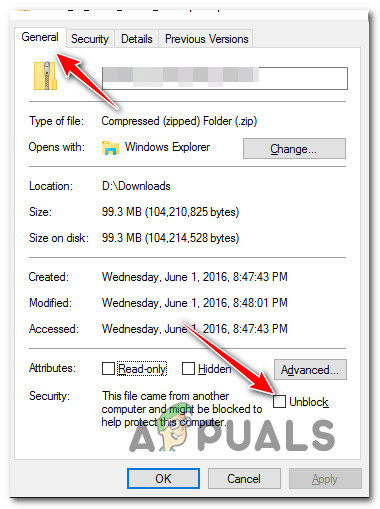
Unblock the .zip file - At the confirmation prompt, click Yes, then wait until the file is unblocked.
- Double-click on the recently unblocked .zip file and extract the files before carrying on the installation normally.
- Double-click on the executable and see if it produces the same ‘Can’t open AsIO3.sys’ error.
If the problem is still not fixed, move to the next method below.
2. Grant yourself full permission for AsIO.sys (if applicable)
If the method above didn’t work for you and you already have installed ASUS drivers, the problematic AsIO.sys file is already installed on your PC.
You might be experiencing this issue because the file doesn’t have full permission to jump into action when called by Windows Installer (during the installation of another ASUS software).
Note This is typically confirmed to occur on systems with aggressive UAC (User Account Control) settings.
To address this issue, go to C:\Windows\SysWOW64\drivers\AsIO.sys and give yourself permission through the security tab. This fix was confirmed to work by most users dealing with the ‘Can’t open AsIO3.sys‘ error.
Important: This method is only applicable if you previously installed another ASUS software and the AsIO.sys supporting file is already installed on your PC.
Here’s what you need to do:
- Start by ensuring that you are logged in with an administrative account.
- Open File Explorer (Windows key + E) and navigate to the following location:
C:\Windows\SysWOW64\
Note: If you can’t spot the AsIO.sys file inside this directory, this method does not apply to you. In this case, skip to the next method below.
- Right-click the drivers folder and choose Properties from the menu that appears.

Access the Properties screen of drivers - On the Properties screen of the drivers folder, go to the Security tab and click the Edit button (near Change Permissions, click Edit).
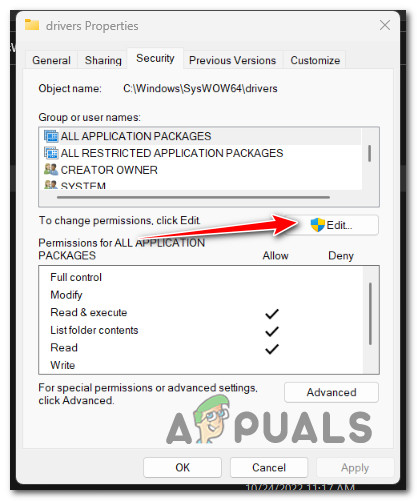
Click on the Edit button - On the Security tab, click the Add button next to Group or user names.

Adding new security for user - In the Select Users or Groups window, type Everyone in the box next to Enter the object names to select (examples), and click OK to save the changes.
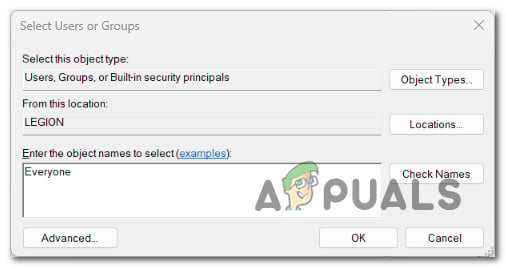
Apply security rule for everyone - Click “Apply” to keep your changes.
- Go back to the volume’s Properties and click on the Security tab. This time, click on the Advanced button (associated with Special permissions or advanced settings)

Access the Advanced Permissions settings - Go to the Permissions tab in the Advanced Security Settings box and click on Change Permissions.
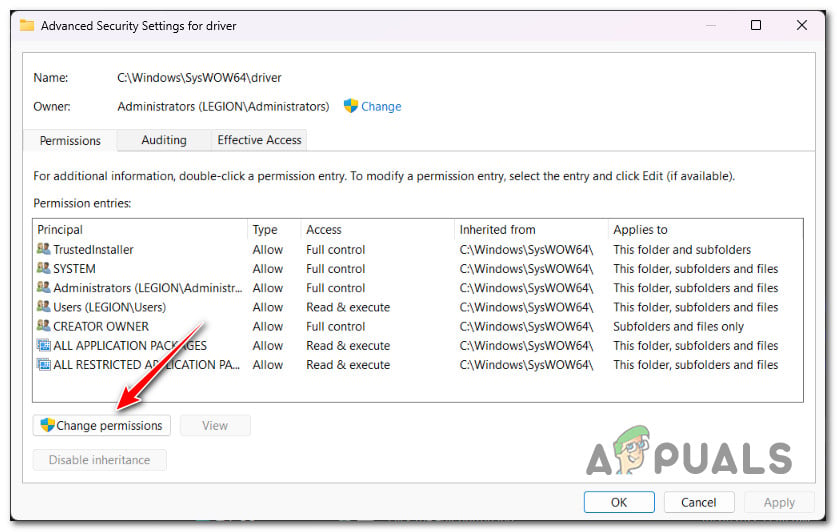
Changing Permissions - In the “Enter the object name to select” field of the “Select User or Group” window, type “Everyone.”
- Make sure the Replace owner on subcontainers and objects option is checked.
- Click the Auditing tab and click Add with Everyone as the owner.
- Choose Everyone as the Principal under the Auditing Entry, then go to the Basic Authorization section and check the box next to Full control.
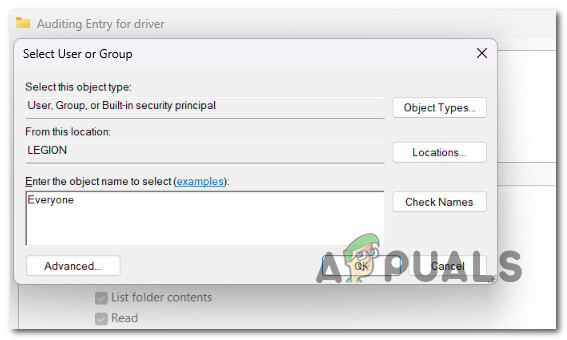
Setting up the ‘Everyone’ value as Principal for every group - Finally, click Ok and then Apply to save the changes.
- Restart your computer and attempt to install the ASUS software once again.
If you’re still seeing the ‘Can’t open AsIO3.sys’ error, try the next method below.
3. Perform SFC & DISM scans
If you’ve reached this point without a workable solution, you should check to see if a corrupted system file prevents you from installing ASUS software (and triggering the ‘Can’t open AsIO3.sys’ error).
If you don’t want to use third-party tools, it would be smart to use a few of your operating system’s tools. (SFC and DISM).
System File Checker and Deployment Image Servicing and Management are two built-in tools that can be used to fix corrupt system files that may stop your OS from utilizing Windows Install dependencies.
System File Checker is the best place to start because it can be run without an internet connection. Follow these steps to deploy an SFC scan.
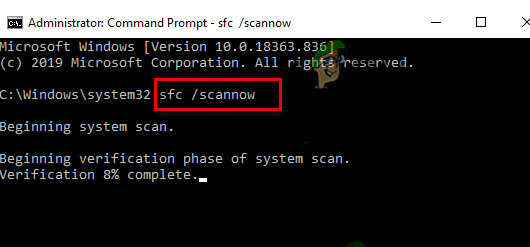
Important: If the System File Checker scan window stops responding while running, DO NOT CLOSE THE WINDOW until the procedure is done.
Note: System File Checker swaps out broken parts of system files with working ones by using a cache that is stored locally. This process shouldn’t be stopped until it’s done to avoid making more logical mistakes. Using an old HDD instead of a modern SSD could take an hour or more (depending on how fast your storage device can read and write).
When the SFC scan is done, restart your computer to see if the ‘Can’t open AsIO3.sys’ error is fixed.
If the problem is still there, deploy a DISM scan.

Before you start this process, you should know that DISM uses a part of Windows Update to replace corrupted files with ones that aren’t corrupted. This means that your Internet connection needs to be stable.
After the SFC and DISM checks, you should restart your computer to see if you’re still experiencing the ‘Can’t open AsIO3.sys’ error.
If the problem keeps happening, move on to the next method below.
4. Install ASUS Armory Crate (if applicable)
Even if you’re not a fan of bloatware (we aren’t either), you should still consider installing the ASUS Armory Crate utility – it will most likely fix the issue automatically.
Note: Armoury Crate is an integration app for gaming laptops and desktops in the ROG and TUF series. It combines different functions, such as the ROG Gaming Center from Gaming NB, the AEGIS III from Gaming DT, Lighting, and AURA Sync from AURA. Installing it serves our purpose of installing all the required dependencies (including the asio3.sys dependency).
The only bad thing about this integration app is that it also installs some bloatware from ASUS. But for the most part, these are non-intrusive and won’t slow down your system.
Follow the instructions below to download and install ASUS Armory Crate:
Important: Only follow the instructions below if you are experiencing this issue on a ROG or TUF gaming laptop.
- Open your browser and navigate to the official download page of ASUS Armory Crate.
- From the Please select OS drop-down menu, select your operating system.
- Next, click on the Download button associated with the recommended version of Armory Crate.
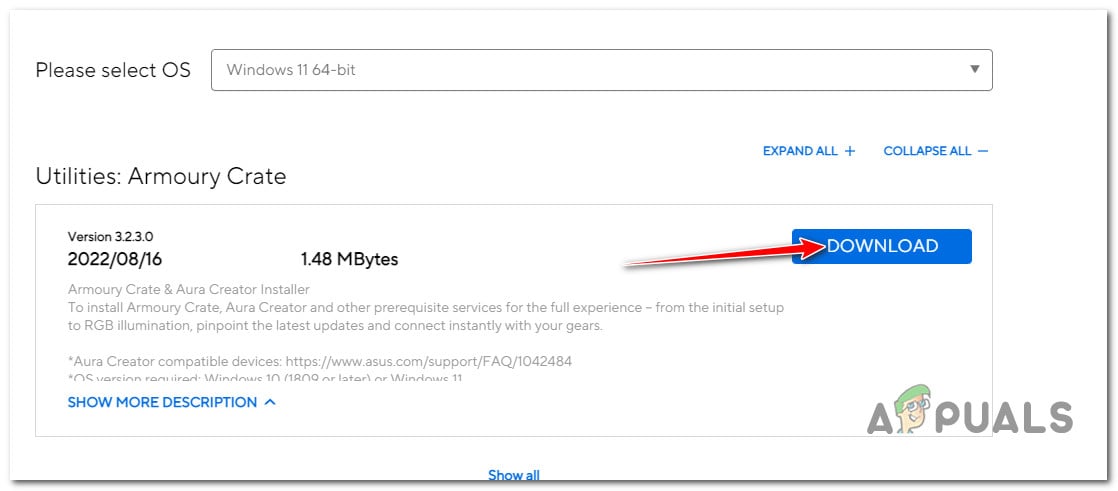
Downloading the ASUS Armory Crate installation executable - Once the executable has been downloaded, extract it using the built-in utility or a 3rd party suite like WinZip or WinRar.
- Next, right-click on the ArmouryCrateInstaller.exe and click on Run as Administrator from the context menu.
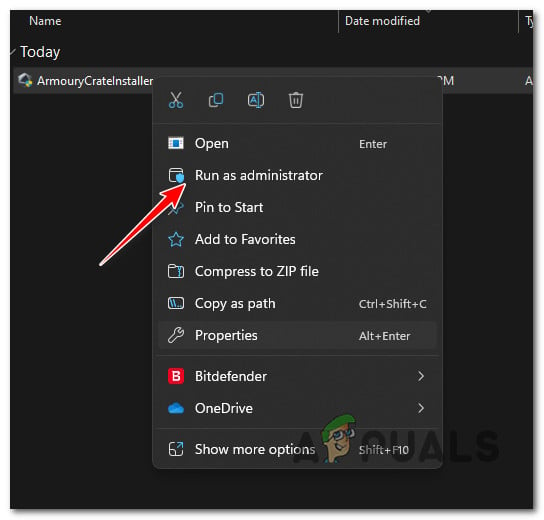
Run the executable as administrator - Follow the remaining instructions to complete the installation, then reboot your PC.
- Once the next startup is complete, repeat the previous action causing the ‘Can’t open AsIO3.sys – Failed with error code 5: Access is denied’ error and see if the problem is now fixed.
If the problem is still not fixed, move down to the next method below where we explore a potential issue caused by Windows Update.
5. Uninstall the latest Windows Security Update
This problem is also caused by a bad Windows security update that Microsoft released for Insider Previews and retail versions on some ASUS laptop models.
If the “Can’t open AsIO3.sys” error started showing up after your operating system installed a security update, uninstalling it should fix the problem for you.
Follow the steps below to get rid of the latest Windows update:
Important: You can hide the update and stop it from being installed again by following the extra instructions.
- Use the Windows key + R to get to the Run box and the Programs and Features page.
- Then type “appwiz.cpl” into the text box where you just typed it.

Open the Programs and Features menu - Go to Programs and Features, and then choose View installed updates from the left-hand menu.
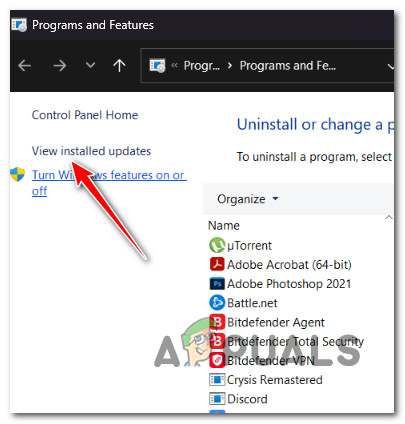
View the recently installed Windows Updates - On the Installed Updates page, look for the most recent update and right-click on it. From the menu that pops up, click Uninstall.
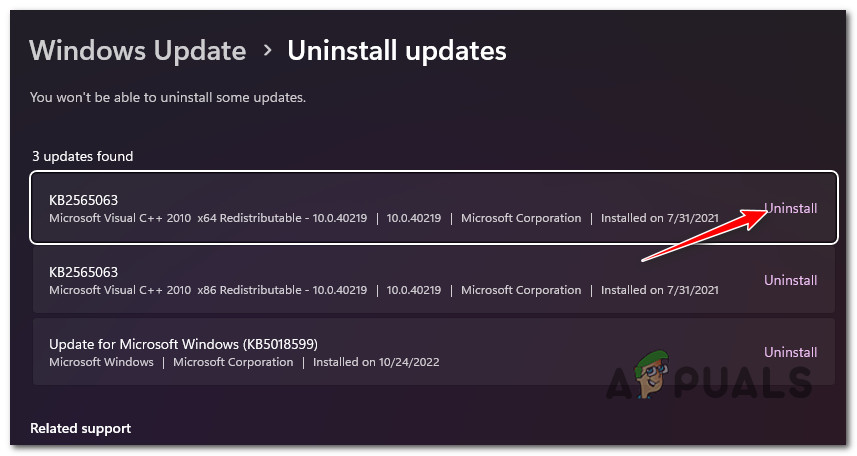
Uninstall the Windows Update that was installed recently - When asked if you want to get rid of the update, choose “Yes.” Let the uninstalling process finish by saying “Yes” when asked to do so.
- It would be best if you didn’t restart your computer after removing the update. Instead, go to the official site where you can download the Microsoft Show or Hide troubleshooter.
- We should start downloading the tool we’ll be using right away.
- After the process, open the .diagcab file and click on Advanced.
- Select the box next to Apply Repairs Automatically and then click Next.
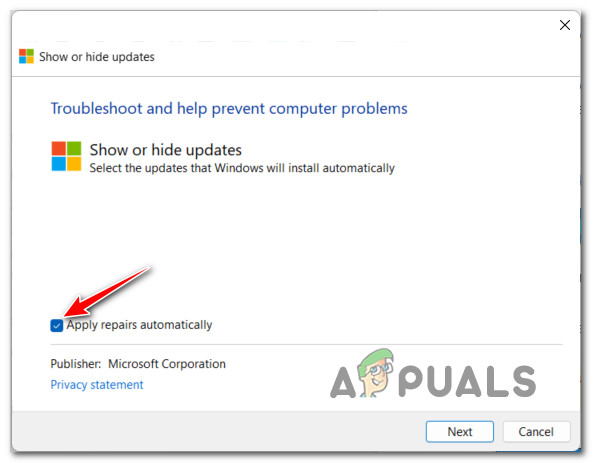
Applying the repairs automatically when using Windows Show / Hide Troubleshooter Note: The program will look through your computer for updates that haven’t been downloaded yet. Choose Hide Updates from the list of options on the next screen to hide updates.
- On the next page, click Next and check the box next to the most recent Windows update. If you do this, the system won’t try to install the same update again.
- Restart your computer once to see if the problem has been fixed.
If the problem is still not fixed, move to the next method below.
6. Install ASUS AI Suite addon (if applicable)
If you followed the method above to troubleshoot an issue caused by a bad windows update, let’s troubleshoot against a potential issue caused by ASUS AI Suite.
If you have this tool installed on your PC, you might want to check if the tool has an available add-on waiting to be installed.
Note: ASUS has released an add-on to tackle this issue for certain laptop models. This will be applied to your existing installation using the manual updating solution from ASUS.
Remember that ASUS AI Suite doesn’t have a dynamic self-updating feature. If you want to ensure that they’re updated to the latest version, you’ll need to run the AsusSetup executable (which can be found inside the download folder) and follow the instructions to install every pending addon.
Here’s what you need to do to install pending add-ons for your ASUS AI suite:
- First, close any currently running 3rd party applications (including ASUS AI Suite).
- Open your browser and download the latest compatible version of ASUS AI Suite (according to your motherboard or laptop model) from the official ASUS download website.
- Next, navigate to the location where you downloaded the latest version of AI Suite and extract the .zip archive.
- Access the extracted folder, right-click on AsusSetup, and click on Run as Administrator from the context menu that just appeared.
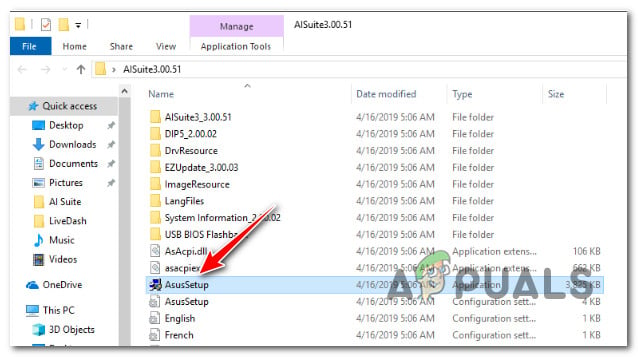
Run the AsusSetup executable with administrative access - Click Yes to grant admin access at the User Account Control (UAC).
- Once you get to the next screen, check every ASUS application box and click on Install to update every underlying application to the latest version.
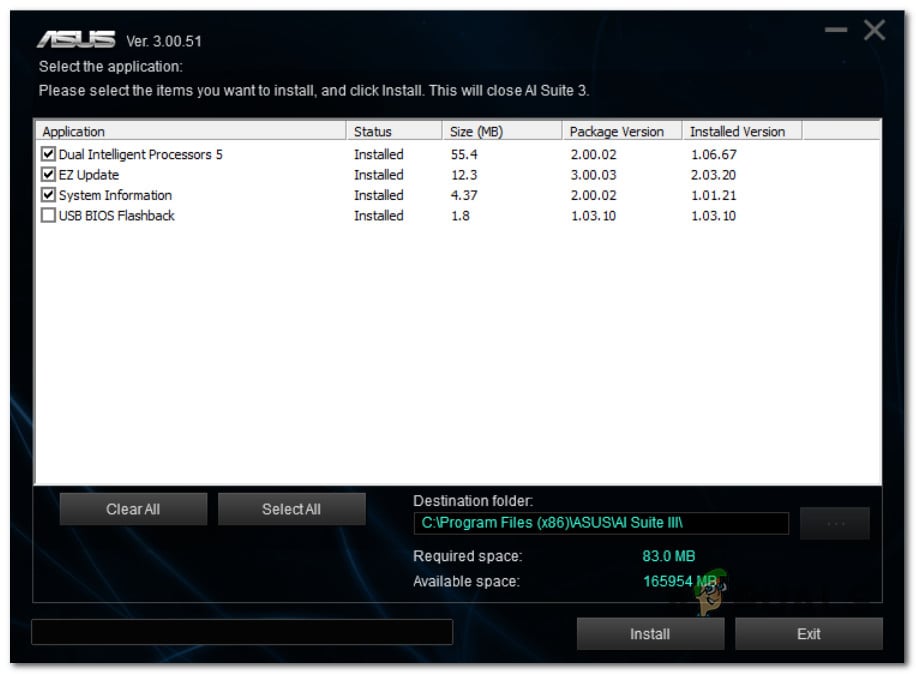
Update the ASUS suite to the latest version - At the end of this process, the installer will confirm that the AI Suite has been updated to the latest version. Click Ok to finish the process.
- Next, you will be prompted to reboot your PC. Do so by clicking Yes.

Confirm the reboot operation - Once the next startup is complete, repeat the action causing the asio3.sys error and see if the problem is now fixed.
If the problem is still not fixed or this method is not applicable, move down to the next method below.
7. Use System Restore to revert the installation of ASUS AI Suite
If this issue started after you updated your ASUS AI Suite version to the latest version, you might be able to revert to a version that doesn’t produce this behavior.
Unfortunately, ASUS only has the latest build of ASUS AI Suite available on their official download website. Your only solution (unless you want to use a 3rd party service like Oldversion.com) is to use System Restore.
Note: System Restore will allow you to revert your system to a previous state in time. By default, this utility is configured to automatically create new restore snapshots at important system events (such as installing a new update for an existing app).
If you didn’t modify the default behavior of System Restore, you should have a restore snapshot created just before the installation of the ASUS AI Suite update.
Follow the instructions below to use System Restore to revert ASUS AI Suite to a previous version:
- Open the Run dialog box, type “rstrui,” and press Enter to launch the System Restore wizard.

Open Restore point - Click Yes if the User Account Control asks you to provide admin access.
- To proceed, click Next on the System Restore window’s first screen.

Get past the initial System Restore screen - Before clicking Next, pick a reliable restore point. If you don’t see the restore point created just before the update of the ASUS AI suite, check the box next to Show more restore points.
- Select a restore point produced before you first ran into the ‘Can’t Open asio3.sys’ error, then click Next to begin the restoration process.
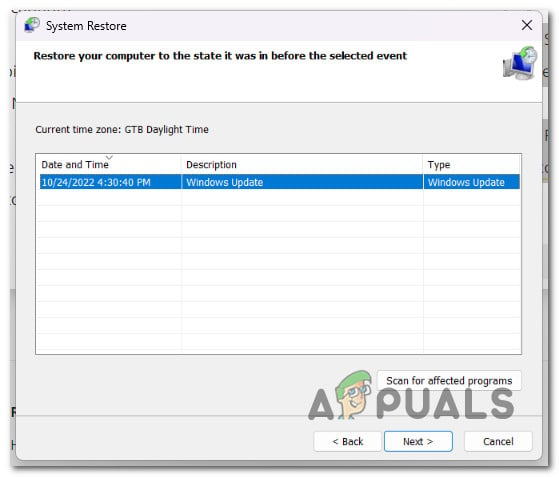
Selecting a viable Restore Point - Restart your computer and repeat the action that was previously causing the issue with asio.sys.
If the problem is still not fixed, move to the next method below.
8. Uninstall Armory Crate using a dedicated uninstaller
If you started experiencing this issue after installing or updating the Armory Crate utility from ASUS, you are not the only one affected by this issue.
We’ve identified dozens of user reports experiencing the same Can’t open AsIO3.sys error due to a bad version of Armory Crate.
To fix it, you’ll have to uninstall the utility.
Important: If you install this suite conventionally (via Programs and Features), chances are you will still experience this issue. Our advice is to use the dedicated Armoury Crate uninstaller.
Here’s how to uninstall Armory Crate using the dedicated uninstaller:
- First, close every 3rd party application (including any utility from ASUS).
- Open any browser and access the official Armory Crate download site.
- On the official download website, start by selecting your OS to get the correct download version.
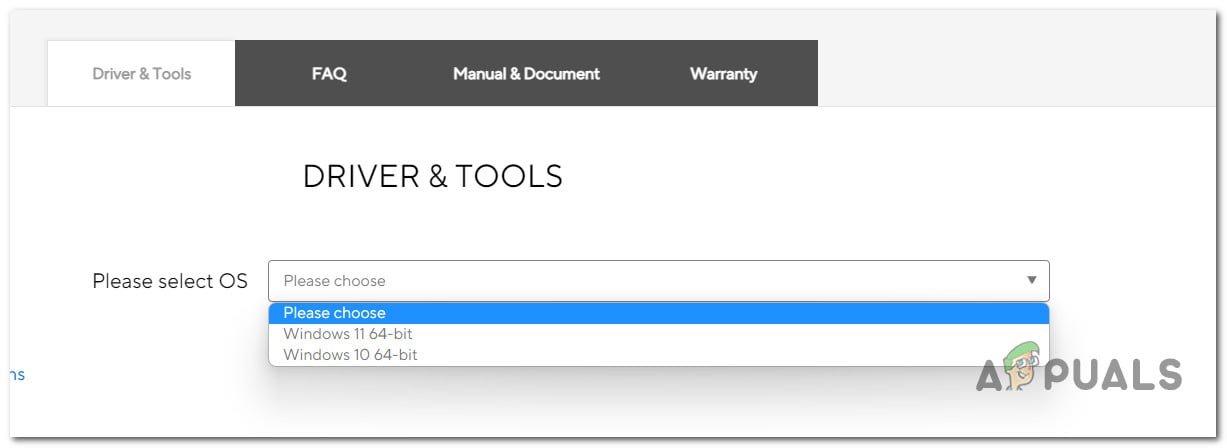
Selecting the correct OS version - After selecting your OS, you will only see the latest version of Armory Crate. When this happens, click on See All Downloads.
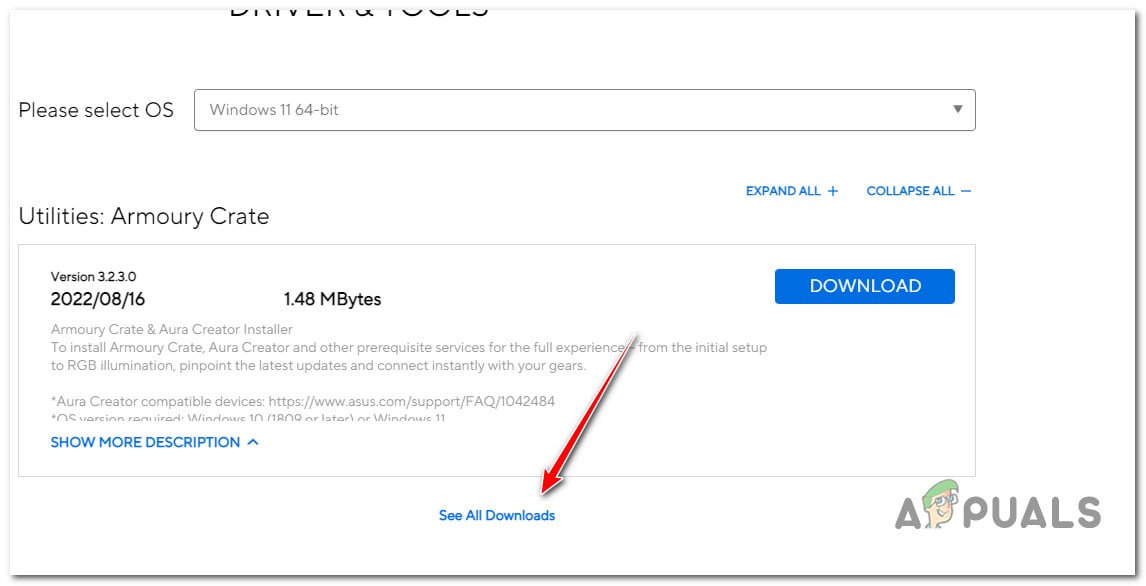
Viewing all available updates - Scroll down to the bottom and locate the Download button associated with the Armoury Crate Uninstall Tool. Click on it.

Downloading the correct uninstaller - Once the download is complete, extract the archive.

Extracting the uninstaller Note: You can use the built-in extraction tool (if applicable) or go for a third party solution (like WinZip or WinRar)
- Once the extraction is complete, right-click on Armoury Crate Uninstall Tool.exe and choose Run As Administrator from the context menu.

Running as administrator - At the User Account Control, click Yes to grant admin access.
- Next, click Uninstall to begin the operation and confirm at the next prompt.
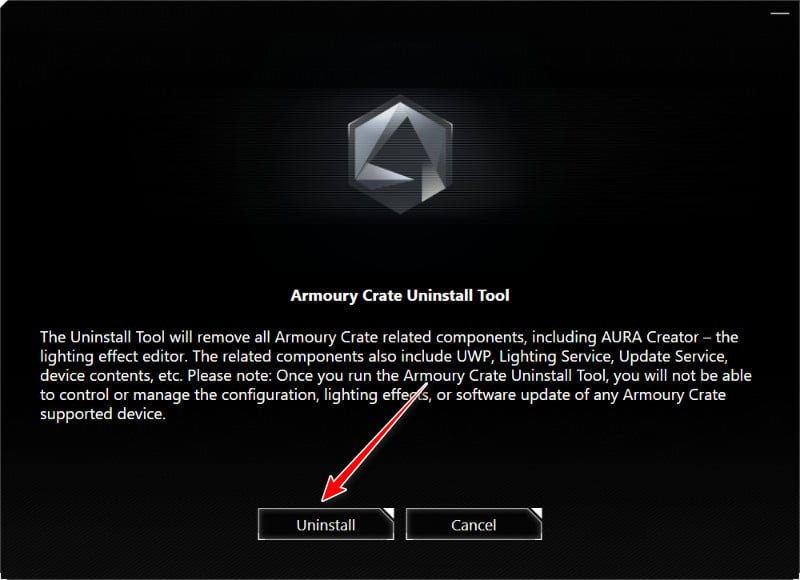
Uninstalling the Armoury Crate - Once the uninstallation is complete, click on Restart Now and wait until your PC boots back up.

Restarting the PC after uninstallation - Repeat the action causing the error and see if it’s fixed.
If you’re still experiencing the ‘Can’t open AsIO3.sys error, move down to the next method below.
9. Enable AsusCertService
If you’re using an aggressive system optimizer suite, there’s a big chance that it ends up blocking the AsusCertService to improve the RAM usage of your PC.
This might be the cause of why you are seeing the ‘Can’t open AsIO3.sys error when opening ASUS applications (because this important dependency is inaccessible).
Fortunately, the fix for this particular issue is simple. You need to access your Service settings and ensure that AsusCertService service is enabled and configured to start at every system start.
Here’s how to do this:
- Press Windows key + R to open up a Run dialog box.
- Next, type ‘services.msc’ inside the text box and press Ctrl + Shift + Enter to open the Services screen with admin access.

Accessing the Services screen - At the User Account Control (UAC), click Yes to grant admin access.
- Once inside the Services screen, use the right-hand pane to locate the Asus Certificate Service.
- Right-click on it and choose Properties from the context menu.

Accessing the Properties screen of AsusCertService - From the next screen, set the Startup Type to Automatic, then click on Start to start the service.
- Click Apply to save the changes.
- Repeat the action that was causing the ‘Can’t open AsIO3.sys’ error and see if the problem is now fixed.
If the problem is still not fixed, move down below.
10. Install the latest Lightning updates via Aura
Another potential cause that might cause this issue is a scenario in which one of your ASUS suites is missing the lightning updates.
Note: This is a more recent dependency required nowadays by every proprietary software released by ASUS.
The quickest way to ensure you have all the required lightning updates is to use Aura Sync to install them automatically.
Remember that Aura Sync is now a part of Armoury Crate, but you can still install it individually.
Follow the instructions below to carry out this procedure:
- Start by closing every 3rd party application, including ASUS software.
- Visit the official download page for Aura Sync.
- The standalone version of Aura Sync Utility can be downloaded by clicking on the hyperlink at the bottom of the page.
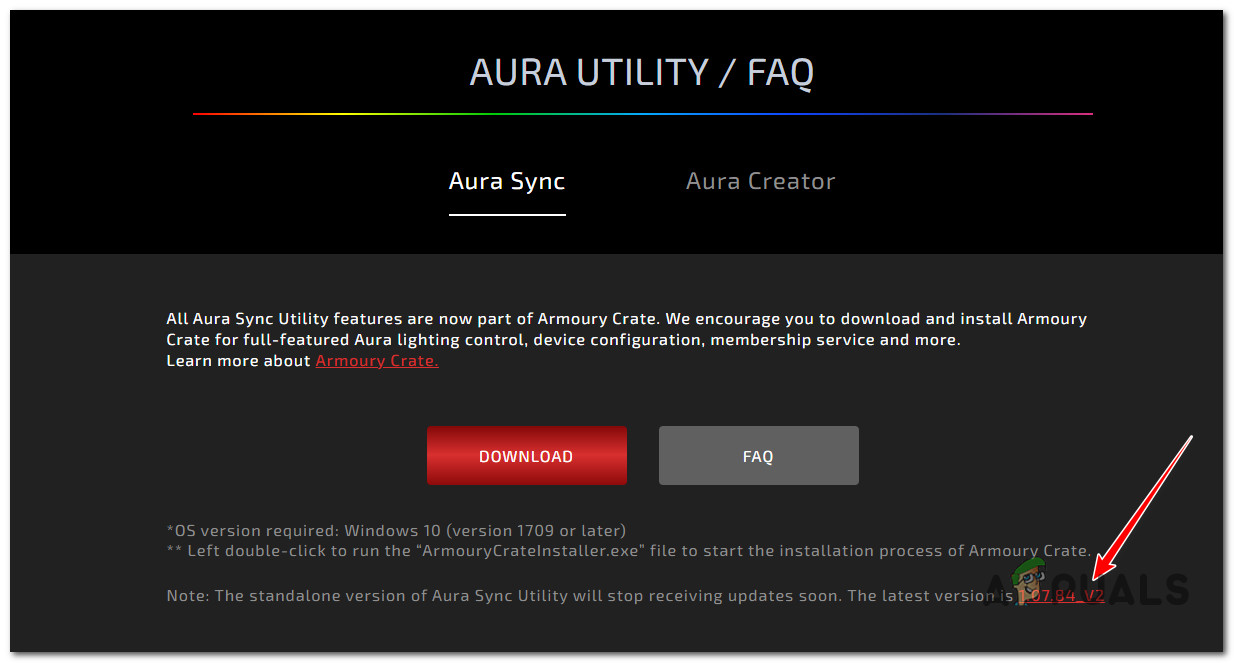
Download the standalone version of Aura Sync - Extract the recently downloaded archive, right-click on Setup.exe and click on Run as Administrator.
- Click Yes to grant admin access from the context menu that just appeared.
- Go through the installation instructions, then reboot your computer once Aura Sync is installed on your PC.
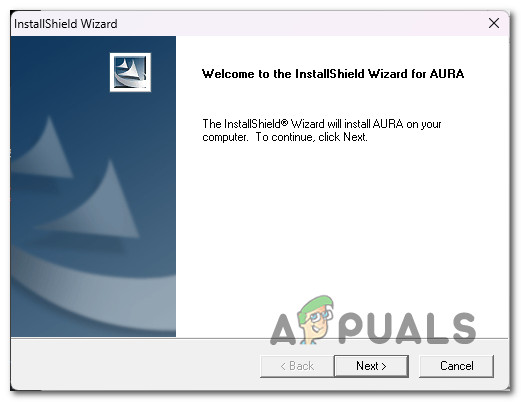
Go through the installation instructions - Run Aura Sync, and you should get a popup asking if you want to install the pending updates. Click Yes and wait until all the lightning dependencies are installed, then restart your PC.
If the problem is still not fixed, move to the next method below.
11. Disable Plugins in iCUE Settings (if applicable)
If you’re using the iCUE software to synchronize the RGB lighting on all your compatible devices, you should know that this software is known to conflict with the ASUS AI Suite and produce the ‘Can’t open AsIO3.sys’.
Fortunately, you can fix this conflict easily by accessing your iCUE settings and unchecking the box associated with Enable plugins.

After you do this, reboot your PC, and the issue should be fixed.
If this scenario is not applicable, move to the next method below
12. Uninstall Asus Probe (if applicable)
ASUS Probe is the final 3rd party conflict known to produce this error. This is legacy software that ASUS no longer supports. Furthermore, it’s known to cause compatibility issues with many of the newer proprietary software from ASUS (ASUS AI Suite, Aura Sync, EZ Flash, etc.)
Note that ASUS Probe doesn’t have any functionality that is not available on the flagship ASUS AI Suite, so you have no reason not to uninstall it if you still have it on your system.
Follow the steps below to complete the installation:
- Press the Windows key + R to open up a Run dialog box.
- Next, type ‘appwiz.cpl’ inside the text box, then press Ctrl + Shift + Enter to open the Programs and Features utility with admin access.

Open up the Programs and Features screen - Click Yes to grant admin access at the User Account Control (UAC).
- Once inside the Programs and Features screen, right-click on Asus Probe and click on Uninstall from the context menu.

Uninstalling ASUS probe - Follow the remaining prompts to complete the uninstallation, reboot your PC and see if the conflict is resolved.
If the same problem is still occurring, move to the final fix below.
13. Perform a clean install or repair install
If none of the above fixes worked and you’re still getting the error “Can’t open AsIO3.sys – Failed with error code 5: Access is denied” after trying all of them, the only thing left to do is to refresh the kernel data along with every Windows file.
Many users who said they had the same problem said it was fixed after they did a full system refresh. You can choose either a clean install or a repair install (in-place repair).
The biggest problem with a clean installation is that you can’t save any of your data unless you first make a copy of everything (apps, games, personal media, etc.). This could take some time to do.
But if you choose the repair install (in-place repair) method, you might be able to save your personal information (including applications, games, personal material, and even specific user preferences). But the process will take a little longer.




